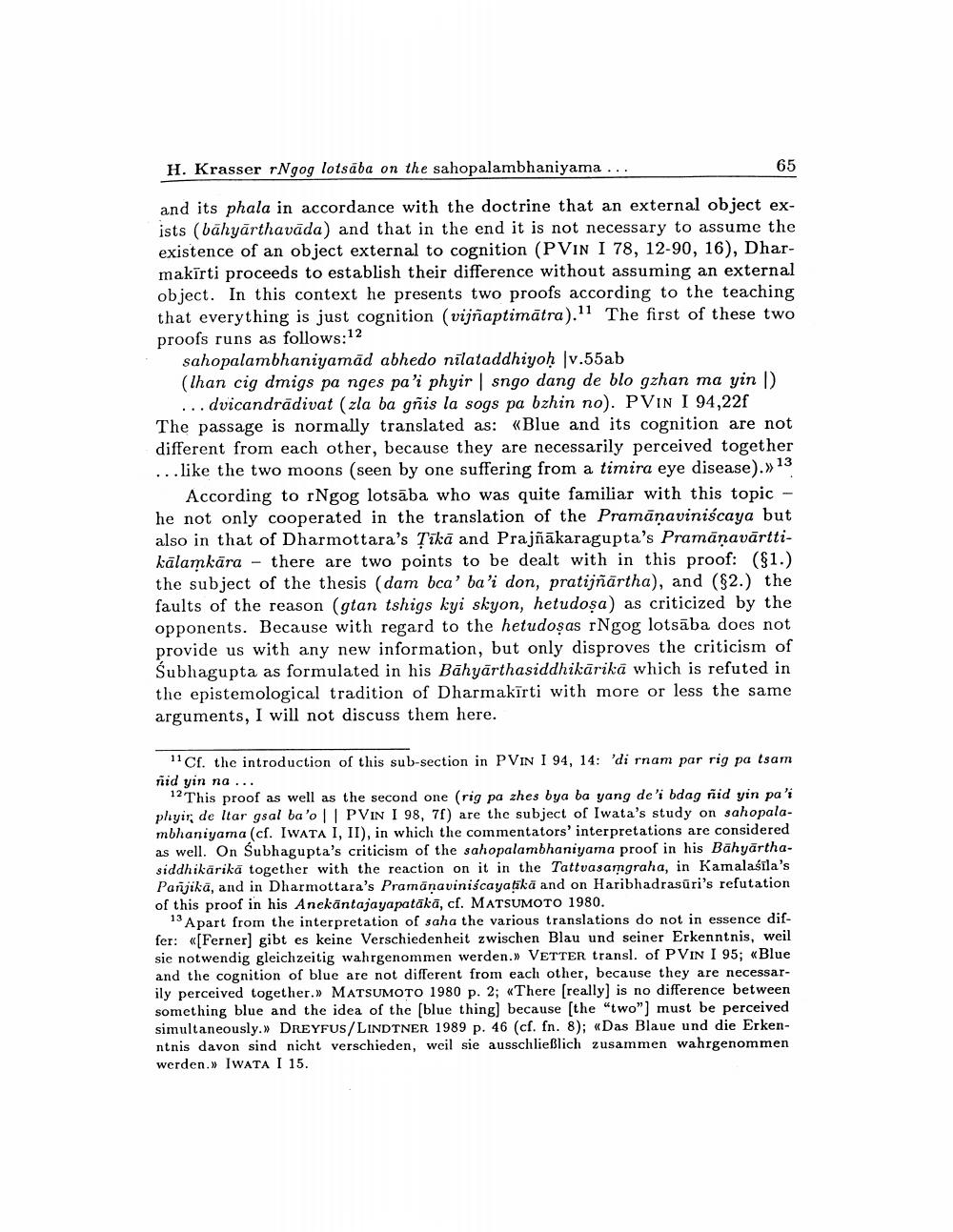Book Title: Rngog Lotsaba On Sahopalambhaniyama Proof In Dharmakirtis Pramanaviniscaya Author(s): Helmut Krasser Publisher: Helmut Krasser View full book textPage 3
________________ 65 H. Krasser rNgog lotsaba on the sahopalambhaniyama... and its phala in accordance with the doctrine that an external object exists (bāhyārthavada) and that in the end it is not necessary to assume the existence of an object external to cognition (PVIN I 78, 12-90, 16), Dharmakirti proceeds to establish their difference without assuming an external object. In this context he presents two proofs according to the teaching that everything is just cognition (vijñaptimätra). The first of these two proofs runs as follows:12 sahopalambhaniyamad abhedo nilataddhiyoḥ v.55ab (lhan cig dmigs pa nges pa'i phyir | sngo dang de blo gzhan ma yin ) ...dvicandradivat (zla ba gñis la sogs pa bzhin no). PVIN I 94,22f The passage is normally translated as: «Blue and its cognition are not different from each other, because they are necessarily perceived together ...like the two moons (seen by one suffering from a timira eye disease).» 13 According to rNgog lotsäba who was quite familiar with this topic - he not only cooperated in the translation of the Pramanaviniscaya but also in that of Dharmottara's Tika and Prajñākaragupta's Pramāṇavārttikālamkāra there are two points to be dealt with in this proof: (§1.) the subject of the thesis (dam bea' ba'i don, pratijñärtha), and (52.) the faults of the reason (gtan tshigs kyi skyon, hetudoṣa) as criticized by the opponents. Because with regard to the hetudoças rNgog lotsäba does not provide us with any new information, but only disproves the criticism of Subhagupta as formulated in his Bahyarthasiddhikarika which is refuted in the epistemological tradition of Dharmakirti with more or less the same arguments, I will not discuss them here. 11Cf. the introduction of this sub-section in PVIN I 94, 14: 'di rnam par rig pa tsam ñid yin na... 12 This proof as well as the second one (rig pa zhes bya ba yang de'i bdag ñid yin pa'i phyir, de Itar gsal ba'o || PVIN I 98, 7f) are the subject of Iwata's study on sahopalambhaniyama (cf. IWATA I, II), in which the commentators' interpretations are considered as well. On Subhagupta's criticism of the sahopalambhaniyama proof in his Bähyärthasiddhikärikä together with the reaction on it in the Tattvasamgraha, in Kamalasila's Panjikä, and in Dharmottara's Pramanaviniscayatika and on Haribhadrasüri's refutation of this proof in his Anekantajayapatākā, cf. MATSUMOTO 1980. 13 Apart from the interpretation of saha the various translations do not in essence differ: «[Ferner] gibt es keine Verschiedenheit zwischen Blau und seiner Erkenntnis, weil sie notwendig gleichzeitig wahrgenommen werden.» VETTER transl. of PVIN I 95; «Blue and the cognition of blue are not different from each other, because they are necessarily perceived together.» MATSUMOTO 1980 p. 2; «There [really] is no difference between something blue and the idea of the [blue thing] because [the "two"] must be perceived simultaneously.» DREYFUS/LINDTNER 1989 p. 46 (cf. fn. 8); «Das Blaue und die Erkenntnis davon sind nicht verschieden, weil sie ausschließlich zusammen wahrgenommen werden.» IWATA I 15.Page Navigation
1 2 3 4 5 6 7 8 9 10 11 12 13 14 15 16 17 18 19 20 21 22 23 24 25 26
